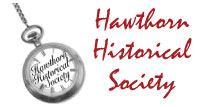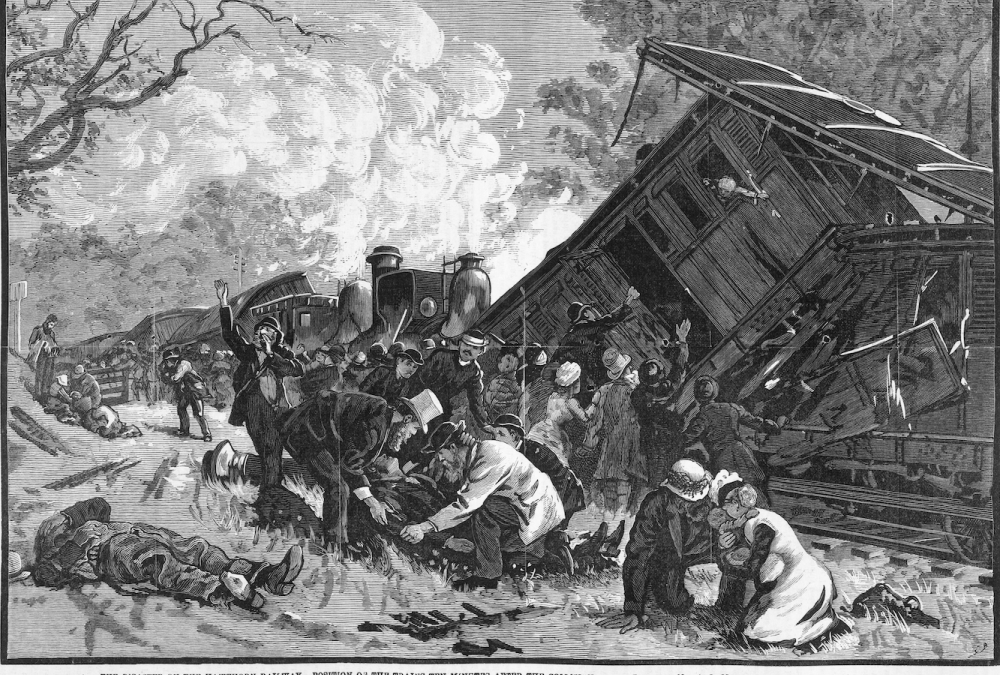On the evening of Saturday,2nd December, the public of Melbourne were horrified by the announcements at the newspaper offices that a serious railway accident had taken place on the Hawthorn line, and later the publication of special editions revealed the fact that a special train travelling from Box Hill to town had collided with the ordinary Hawthorn train, which had left town shortly after 6 pm…. Illustrated Australian News, December 1882.
It was indeed an horrific accident and it remained the main topic of conversation for Melburnians in the following weeks and early months of 1883. As is still the case today, the general public, the political opposition and the newspaper journalists, wanted some quick answers.
How could this have happened? Who was to blame?
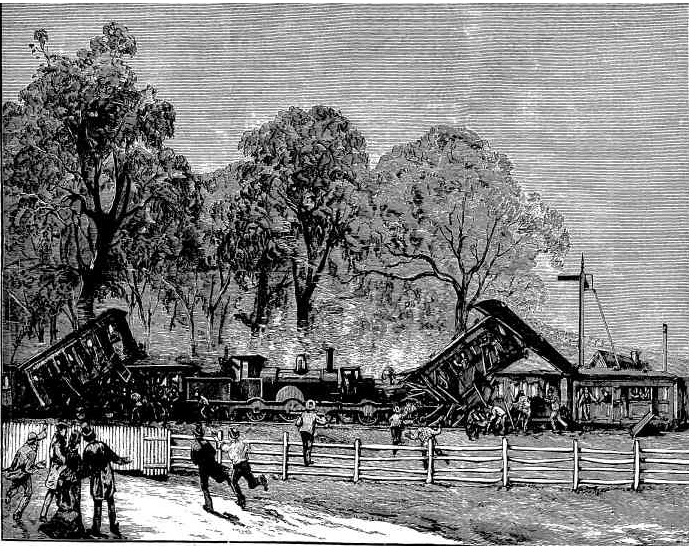
The Hawthorn station had opened on 13th April 1861 and for the next twenty years it was the terminus of the branch from Richmond. Initially the viability of the line was under threat – the high fares and the single platform with limited station facilities, certainly discouraged wider patronage but as the population grew and tcabs were introduced to ferry passengers to and from the station, it soon attracted a larger patronage. Initially the line was operated by a privately owned company, the Melbourne and Suburban Railway Company. In 1865 this was absorbed by its competitor and rebranded as the Melbourne and Hobson’s Bay United Railway Company but then in 1878 the line was taken over by the Victorian Government.

Steam train from Richmond crossing over the rail bridge to Hawthorn. Source unknown.
In April 1882 the rail line was extended from Hawthorn to Camberwell and on 1st December of that year, to Box Hill and beyond to Lilydale. However, the double line of rails was only completed as far as the Hawthorn station by the end of November and on the day of the accident only a single track between Burnley and Hawthorn was in operation, the old line being closed because of repairs to the Hawthorn bridge.
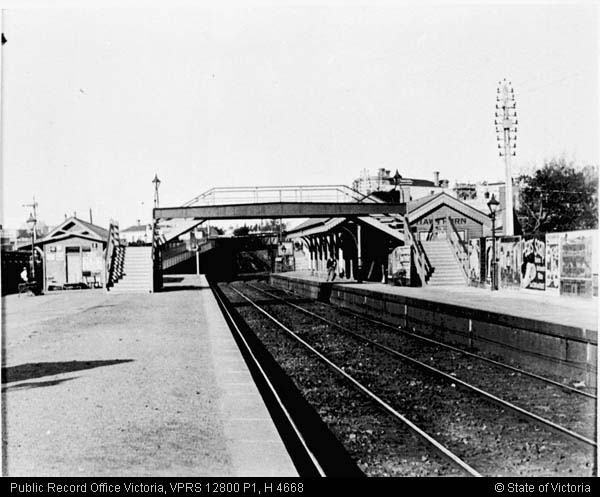
The opening of the extended railway line encouraged a growth corridor into the eastern suburbs and accordingly many new housing subdivisions were released. Developers offered inducements such as free train travel and luncheon on site to sell the idea of ‘a day out” and to attract potential purchasers. The Box Hill station opened on 1st December and the following day, Saturday 2nd December, a special train was authorised to take people from town to the new land sales in Box Hill, which were advertised to be within a mile of the new station. At 3 o’clock G W Taylor was to sell The Box Hill Park Estate, 176 of the Grandest blocks ever offered to Public Competition. This would be followed Immediately by the sale of 40 acres land in Elgar road offered by John Clarke and Co. At the conclusion of the day the Special Train was to return to Melbourne with the intention to reach Hawthorn at 6.21 pm and not leave there until the regular service train coming from Melbourne had arrived at the station.
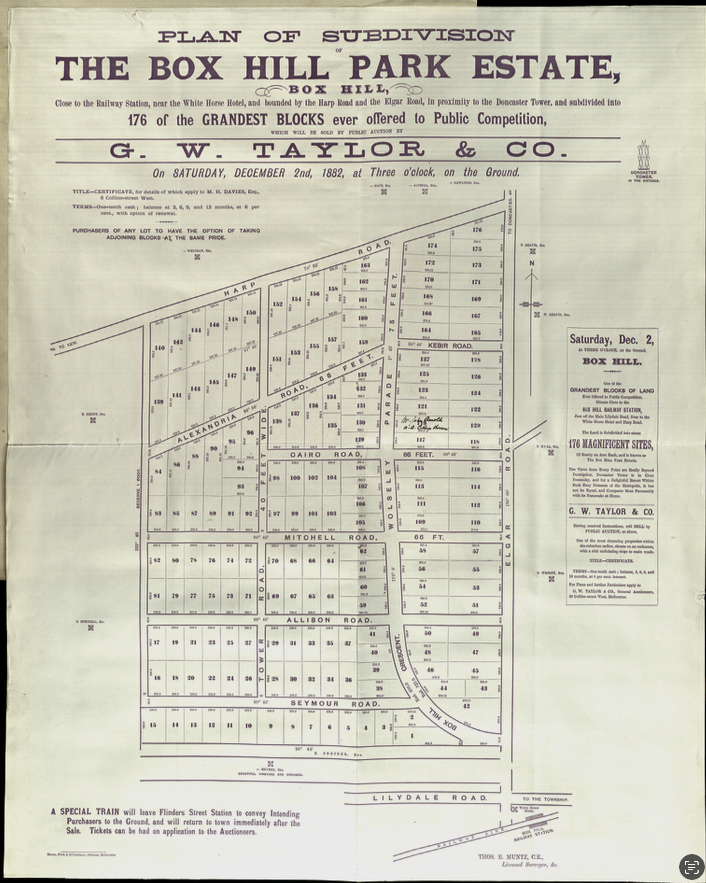
However, confusion about how to interpret the printed timetable, unsynchronisation of watches and errors in communication down the chain of command from the Railway Department, to guards, drivers and station masters, were all factors that seriously contributed to the final critical event – when the Special train arrived several minutes early at Hawthorn, it was waved through by the station master, who thought that the two trains would pass at Burnley. The Special train then preceeded to cross the rail bridge uneventfully and travel towards the Survey Paddock near the old Pic Nic station on the Richmond side of the river. However, the two trains were now travelling in opposite directions on the same line and met in a disastrous head-on collision at a curve in the line. The drivers saw nothing of each other until it was too late and despite each giving warning whistles and attempting to brake and reverse their engines there was insufficient time for either train to brake in time.
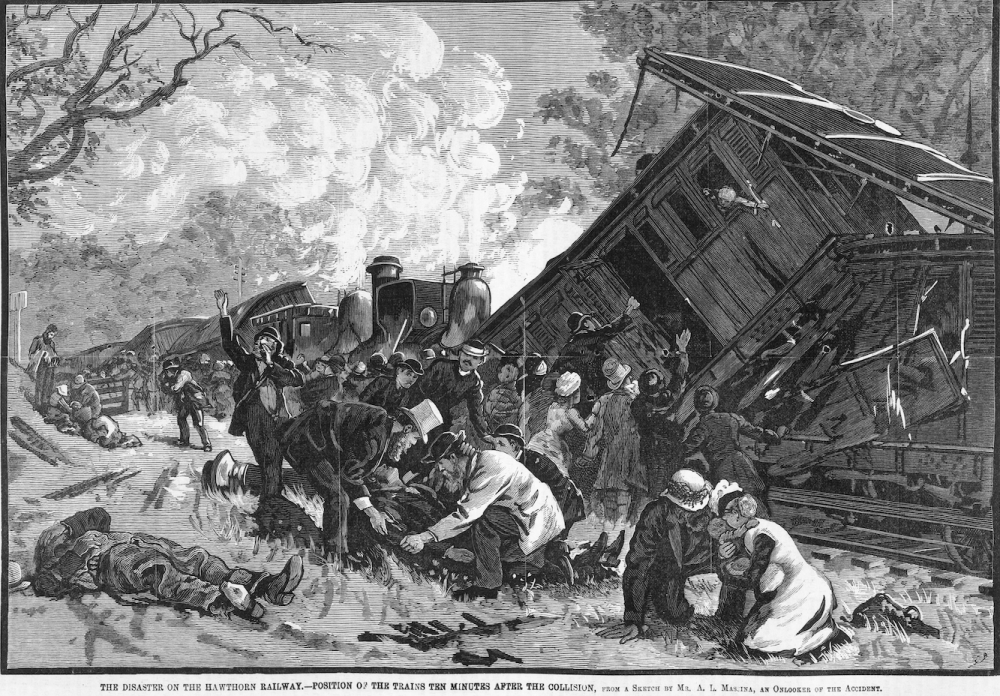
The carnage was formidable. Four carriages were totally wrecked, many passengers were thrown about within and out of the train and were found mangled amongst the debris of seats, wheels, and ironwork. Wtitnesses described the screaming, blood and dazed and disorientated passengers. Over 70 persons suffered injuries, many with fractured ribs, broken limbs, head injuries and other wounds. Miraculously, no one was killed outright, although one later died from his injuries.
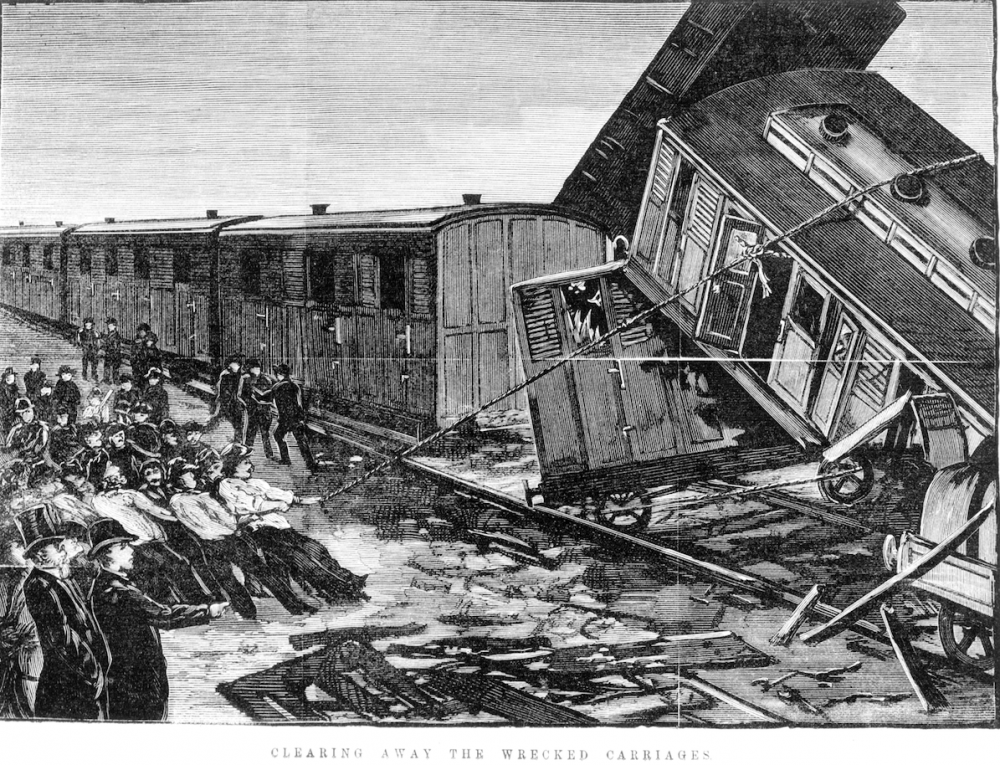
Mr Alfred Massina of the firm A. H. Massina and Co., printers of Little Collins Street was an eye witness to the frightful catastophe as he lived only about 50 yards from the scene. Hearing the sharp whistles he rushed to the back door of his home in time to see the trains collide. During the long evening he was able to make several sketches of the scene to create wood blocks which later appeared as illustrations in several newspapers.
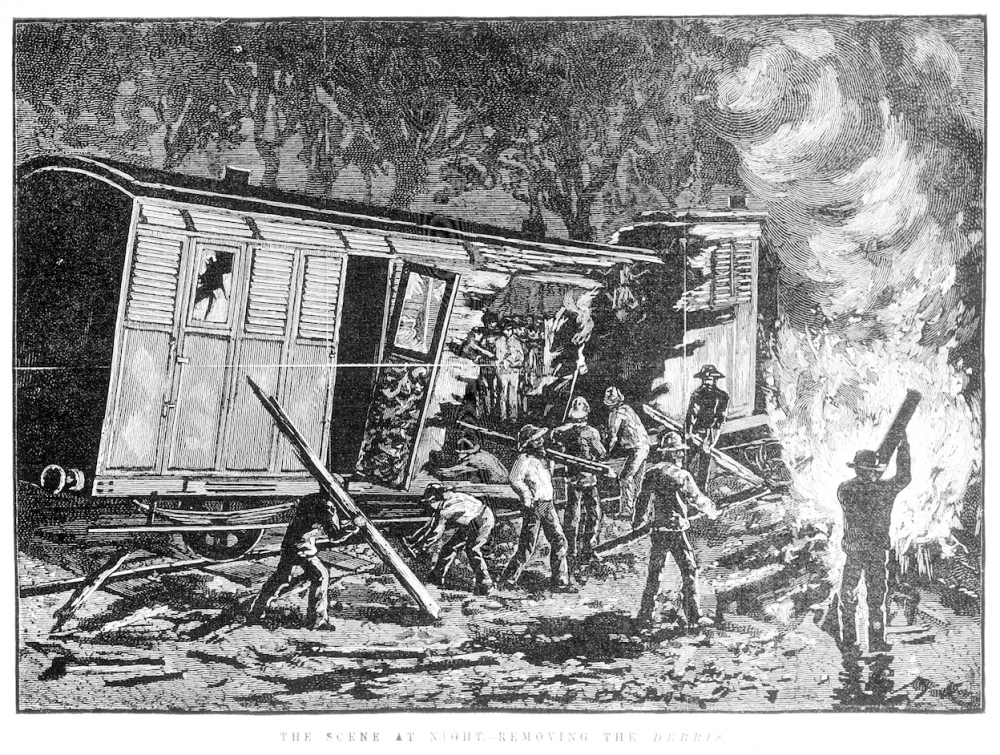
One local lad, Master Harold Drew was later commended for his good services. The young man, out riding on his pony, heard the sharp whistles of the engines, followed by a crash which was of such a deafening character that it frightened his pony, and he was thrown off. Catching his pony, he then rode quickly to the crash site and from there to the police station and to the cab rank alerting them to send every available vehicle to the scene to render assistance. Although there were few residents nearby, the news travelled like wildfire and people thronged to the scene of the crash from the surrounding areas. Some passengers who lived in Hawthorn or Kew were transported home to be tended to by their local doctor whilst many others were carried to Mr Robert Wylie’s dispensary in Burwood Road, or were transferred by various other means to a special ward set up at the Melbourne Hospital.
An extra train were ordered from Melbourne to ferry passengers away from the scene Gangs of men were sent to clear the track and fire crews continued to work long into the evening so that by morning there was no trace of the accident.
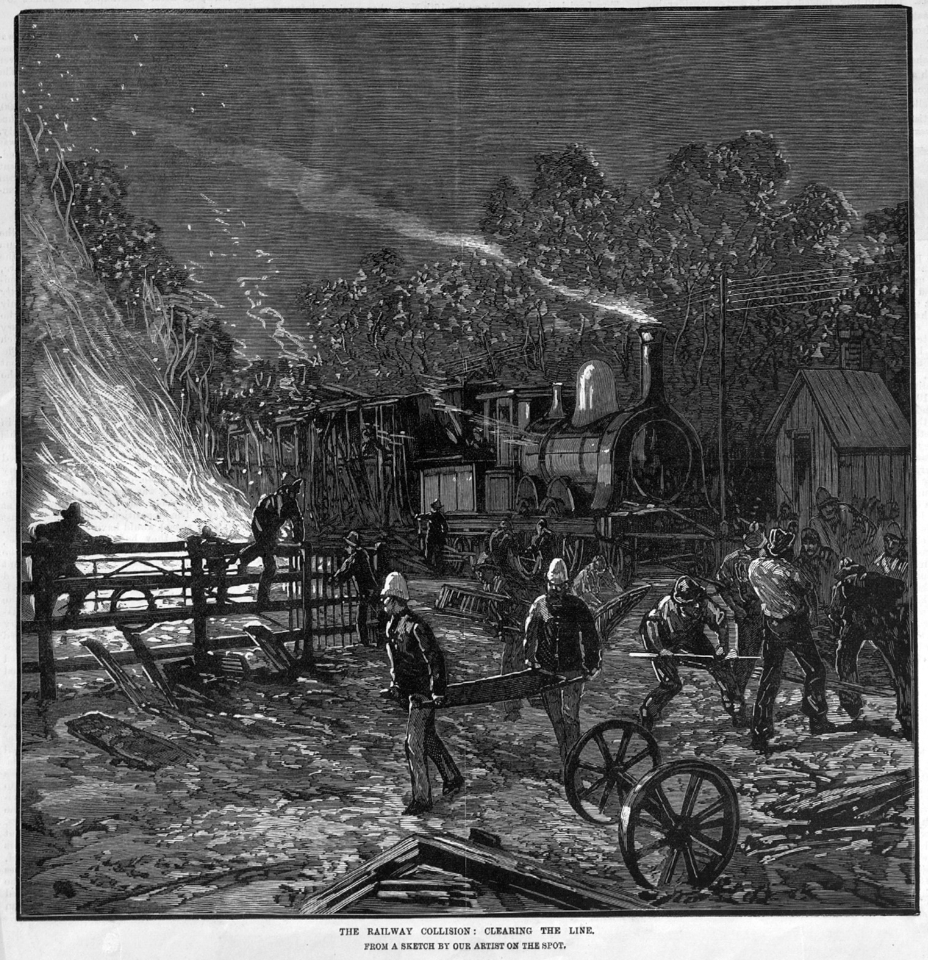
Could this have been an attempt to make a case for “Nothing to see here!”
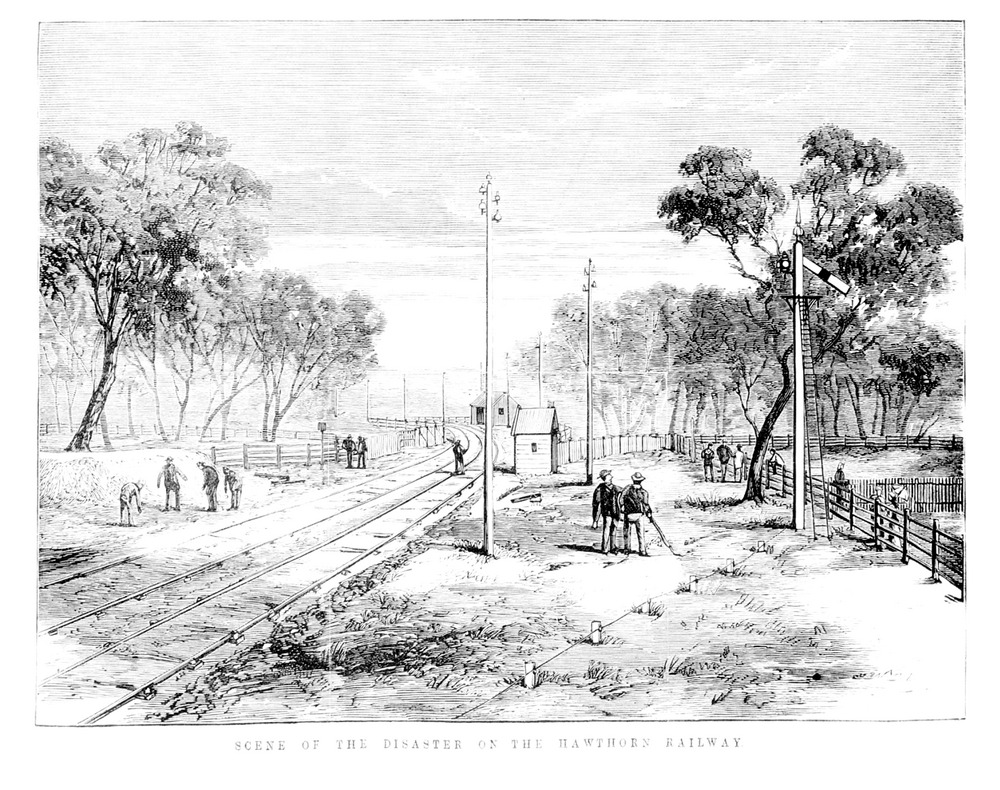
Indeed, three days after the accident, the Premier of the day, Duncan Gillies, announced in Parliament that whilst the Government intended that the fullest enquiry should take place to find out who was the culpable person in the matter, he asked the House to refrain from discussing the question.
Not unexpectedly the atmosphere in the House became heated, with issues raised about the quality of train braking systems and their relevant costs, as well as misleading timetabling and poor communication. However, broader matters were also canvassed, such as delays in the presentation of railway bills, the inadequate expenditure on the railways, the political appointments to the department and the appropriateness of a government minister as manager of the Hawthorn railway in the place of an independent board of management. (Ballarat Star, Wednesday 6th December 1882, p 3).
Of course it soon became apparent that there was no single or simple cause for the accident and again no easy solution to prevent further occurrences. No doubt this complexity contributed significantly in undermining the public’s confidence in the safety of the railway system. It is interesting reading these articles written 140 years ago and realise how many parralels there are with life today.

Official statements were made, political ammunition was duly fired, the coroner held a thorough investigation in late December into the death of a patron, Mr William Cozens Thomas, aged 55 yrs, late care-taker at Wesley Church. The coroner’s report took a broad view, castigating the then Minister for Railways, Thomas Bent for interference in the management of the line. It is interesting to note that the name Thomas Bent, later Sir Thomas Bent, is now often referenced in association with the phrase “Bent by name and bent by nature.”
The coroner did however, also commit Benjamin Thompson, the Hawthorn station-master and the guard of the Box Hill Special train, William Hunt, on charges of manslaughter of William Thomas. Both men were given bail but made to appear for trial in the Supreme Court before Mr Justice Holyrood in February 1883, but both were later acquitted of criminal negligence.
Eventually, the Government Inquiry was held and its report was tabled.
A Hawthorn Railway Collision Board was established to deal with compensation. The newspapers of the day reported the details of the claims made against the Board of Land and Works and also the resultant awards made at the Hawthorn Railway Arbitration Board hearings. There were suggestions of inflated claims by both patients and their doctors but there is still no doubt that were many of the claimants had been significantly impacted by the accident, including pregnant women and children. The Leader on 30th June 1883 reported, Henry Homes an upholsterer residing at Hawthorn sustained a shock to his nervous system and several bruises about the body, which incapacitated him from attending to his work for some time. The case was settled by consent, the damages being fixed at £150. Another Hawthorn resident, real estate agent, Henry John Hellicar, living in Muir Street, Hawthorn, whow as in the second carriage with his son and the gentleman, Mr Thomas who died the next day, was unable to work for two months. He was awarded £440.5s.
The architect George Raymond Johnson, who lived in Yarra Street near the Hawthorn station, was also a first class passenger traavelling on the train from town and he had provided a vivid first-hand account of his experience in the Leader newspaper on 9thDecember. He now claimed for loss of income and his injuries which had been variously described in reports as a fractured jaw or dislocated jaw, concussion, a broken toe and injury to his eyesight, all incurred when he was thrown violently to the floor of the carriage. Although Johnson had claimed £7500, he was only awarded £2481. However his large compensation claim, drew further social commentary. One of his doctors, Dr. Beaney, had prescribed champagne amongst other things following his recovery from the train accident and of this beverage the patient had consumed about £200-worth.
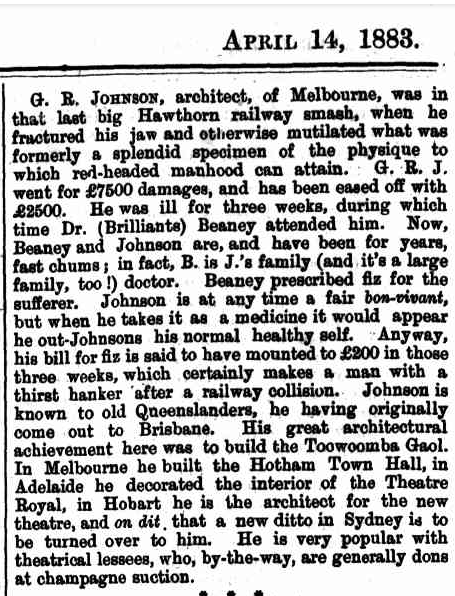
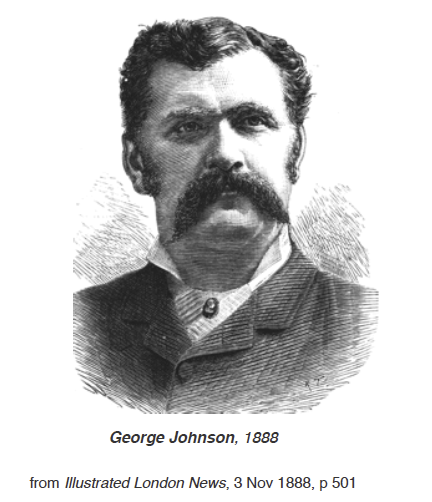
Many other commuters residing further afield also received compensation. These included the stonemason Mr Richard Aysh and his wife, who were awarded £133 and £198 respectively.
Reading the newspaper articles about the train collision for this blog, I was struck by how easy it was to create a vivid picture of the scene of the collision. A reader begins to understand how public concerns of the day were expressed, how information was shared with others and to reflect on the decisions made by both the individuals and institutions involved. Through this kind of activity we may discover and understand our past, knowledge which will in turn inform our future. This article was only possible because of open access.to these newspapers through the National Library of Australia’s digitalization project, TROVE and it is currently available to all, researchers as well as any indivdual member of the Australian or international community who can obtain access to a computer. However, financial support for this wonderful project is now under immediate threat. Consequently if you enjoyed reading about the past, the Hawthorn Historical Society urges you to sign a petition and seek your local Federal member’s support for the continuation of TROVE funding.
Petition EN4747 – Fully Fund TROVE
https://www.aph.gov.au/e-petitions/petition/EN4747
Elizabeth Love, 3rd March 2022
Sources:
The Australian Dictionary of Biography
The Albury Banner and Woodonga Express Dec. 8th 1882
The Australasian Sketcher with pen and pencil, December 16th, 1882
Illustrated Australian News, November 29th, 1882, Special Edition
The State Library of Victoria
The Argus, Dec 5th, 1882
The Ballarat Star, Wednesday 6th Decmeber 1882
The Argus Thursday 12th April 1883
The Queensland Figaro, Saturday 14th April, 1883
The Leader, 25th September 1908
